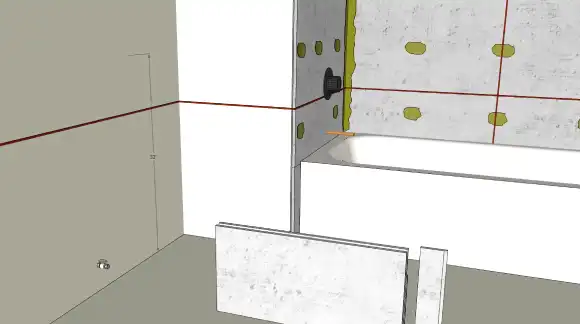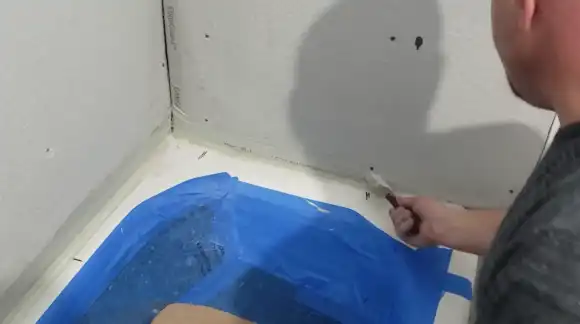Last Updated on September 16, 2023
Gaps between your bathtub and cement board are annoying and pose potential water-seeping risks. As a result of this risk, the cement board is prone to damage, and mold can grow on it. But there are some reliable and effective solutions to seal these gaps to eliminate these issues.
A waterproof silicone sealant can caulk small gaps between your bathtub and cement board to prevent water from seeping in. You can also use waterproof banding material to create a watertight barrier or seal and tape the seam to protect against moisture.
Today we will discuss these simple and effective methods to solve this problem. Don’t let these gaps between your bathtub and cement board cause misery. Keep reading for more information.
What to Do With Gap Between Tub and Cement Board: Things You Can Do

If you have a gap between your tub and the cement board, there are several things you can do to address the issue.
- Caulk the gap between the tub and the board
- Use waterproof banding material
- Seal and tape the seam
Let’s discuss these considerations in detail:
1. Caulk the Gap Between Tub and Board
To achieve a watertight seal, ensure you have waterproofed the area with a liquid membrane. Leave a ⅛” gap between the backer board and the tub. Now fill this gap with a high-quality sealant such as 100% silicone or urethane. You can use an ASTM C920 silicone or a urethane sealant for the best results.
Make sure to fully cover the gap to prevent water from leaking in. Allow the sealant to dry and cure according to the manufacturer’s instructions.
2. Use Waterproof Banding Material:
To protect against water damage, consider using waterproof banding material like Kerdi-Band to seal the area around the tub effectively. This material prevents moisture from seeping into gaps between the tub and the cement board.
To use it, first, apply a waterproof adhesive like Kerdi-fix on the tub flange and thin-set mortar on the backer board. Then, embed the Kerdi-band into these adhesives to create a watertight seal.
This method ensures that any potential leaks or splashes are contained and do not cause damage to the surrounding areas. Using waterproof banding material is an excellent way to provide extra protection for your bathroom renovation project while maintaining a professional finish.
3. Seal and Tape the Seam:
To seal and tape the seam, follow these steps:
- Choose a waterproof sealant such as Wedi sealant, Kerdi fix, or a waterproof polyurethane sealant.
- Apply the sealant along the gap between the tub and cement board, ensuring complete coverage.
- Place 2-inch alkaline-resistant mesh tape over the seam.
- Secure the mesh tape with the chosen sealant using a product like Wedi glue.
- Use a small putty knife to spread the sealant smoothly across the mesh tape, ensuring good adhesion.
This method creates an additional layer of protection and effectively bridges gaps, preventing water damage in your bathroom renovation project.
What to Consider When Sealing the Gap Between Tub and Cement Board?
When considering sealing the gap between your tub and cement board, remember three key points.
Waterproofing Material:
To properly seal the gap between your tub and cement board, use 100% silicone or a waterproof polyurethane sealant for a long-lasting, watertight solution. These materials offer excellent waterproofing properties and are designed to withstand moisture and prevent leaks.
100% silicone is a popular choice due to its flexibility, durability, and resistance to mold and mildew. It adheres strongly to tubs and cement boards, forming a strong bond that remains intact even with frequent use.
Waterproof polyurethane sealants also provide reliable protection against water damage. They have excellent adhesion properties and can effectively fill gaps or cracks between the tub and cement board.
Both options provide a seamless finish that prevents water from seeping through and enhances the overall appearance of your bathroom. Ensure you carefully follow the manufacturer’s instructions when applying these materials for optimal results.
Gap Size:

Ensure enough room between your bathtub and the cement board for a proper seal. The recommended gap size is 1/8 inch, allowing flexibility and preventing cracking caused by expansion and contraction. The small space ensures that waterproofing or sealants can effectively protect the joint.
By leaving this gap, you allow for natural movement of the tub and cement board without putting stress on the joint. This is especially important in bathrooms where temperature and humidity fluctuations are common.
Without this necessary space, the joint could become compromised over time, leading to leaks and potential structural damage.
Mesh Tape:
Mesh tape is crucial in reinforcing the sealant and adding strength to protect against water damage in your bathroom. It is specifically designed to withstand the alkalinity of the sealant, preventing deterioration over time.
Applying mesh tape over the gap between the tub and the cement board creates a strong bond that prevents moisture from seeping through. This helps to prevent potential issues such as mold growth or structural damage.
The tape acts as a reinforcement, minimizing movement or shifting between the tub and cement board, which enhances the overall effectiveness of your bathroom waterproofing efforts. Remember to apply an even sealant layer before placing the mesh tape to ensure optimal adhesion and coverage.
Do I need to leave a gap in the cement board and a tub?
Although it may seem counterintuitive, you must leave a 1/8-inch gap between the cement board and tub for proper installation. This gap is important in preventing water damage and ensuring the long-term durability of your bathroom project.
By leaving this small space, you provide room for any potential movement or expansion due to temperature or moisture level changes. The cement board could crack or shift without this gap, leading to leaks and structural issues over time.
How to seal a big gap between a bathtub and a wall?
To seal a wide gap between a bathtub and a wall, follow these steps:
- Fill the rear end of the gap with a foam backer rod.
- Choose a high-quality caulk designed for wet areas.
- Apply a bead of caulk over the foam backer rod, covering the gap completely.
- Smooth the caulk with your finger or a caulking tool for an even finish.
- Allow sufficient drying time before using your bathtub or shower.
What is the best caulk for large gaps between the tub and the cement board?

Using a high-quality caulk specifically designed for wet areas is best for the most effective seal. Expandable foam caulk is better when filling larger gaps between your bath and the wall.
Regular caulk can shrink and crack over time, but expandable foam caulk expands to fill gaps and holes, providing a durable and long-lasting seal. It also has excellent water resistance properties, making it ideal for bathrooms.
With good adhesive properties, this sheet can adhere well to tubs and cement boards, ensuring it stays in place despite frequent bathing.
Sealing the Gap Between the Tub and Cement Board With the Best Filler
As we know, several materials exist regarding the gap between your bathtub and the cement board. If using caulk, silicone sealant, or both, ensure the product is designed specifically for bathroom applications.
It is important to properly seal this gap to prevent any water damage or mold growth. Sealing the gap properly ensures a long-lasting and watertight connection between your tub and the cement board.



